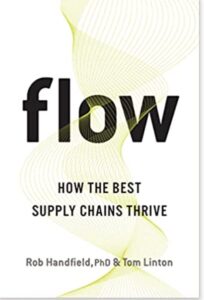Global Independence: Reimagining the “What if Scenario”
Here’s another blog from my colleague, Rajinder Bhandal from Leeds University. She had a chance to speak with Pete Guinto, another colleague of mine at Resilinc. Here’s a summary of their conversation…
Can the notion of global independence help contribute towards building supply chain resiliency? Rob Handfield and Tom Linton, motivate this notion in ‘Flow: How The Best Supply Chains Thrive’ by drawing on the unique work implemented by Resilinc, which has also featured in the book. Thanks to Handfield and Linton (2022) global independence can be understood in the following way:
“Global independence is a key attribute for creating supply chain immunity. The goal should be to maintain domestic sources where doing so makes sense in terms of national security and to create a global network of trusted suppliers willing to become part of the blockchain / visibility network” (p.78, 79).
 Established in 2010, Resilinc is regarded as a leader in supply chain resiliency, with the main aim of examining and mapping supply chains and suppliers globally, towards increasing competitive advantage and efficiency in operations. I had the pleasure of speaking with Peter Guinto, who is the President of Government, Defense and Aerospace Business at Resilinc about the ‘art’ of managing supply chains in a volatile environment. Incidentally, back in 2015, Resilinc were already fully engaged in this type of discussion with an article published on the theme: How Can Sun Tzu’s The Art of War Help Your Supply Chain Resiliency Planning? Here are Peter’s insights from our discussion in which I’ve captured the main essence of:
Established in 2010, Resilinc is regarded as a leader in supply chain resiliency, with the main aim of examining and mapping supply chains and suppliers globally, towards increasing competitive advantage and efficiency in operations. I had the pleasure of speaking with Peter Guinto, who is the President of Government, Defense and Aerospace Business at Resilinc about the ‘art’ of managing supply chains in a volatile environment. Incidentally, back in 2015, Resilinc were already fully engaged in this type of discussion with an article published on the theme: How Can Sun Tzu’s The Art of War Help Your Supply Chain Resiliency Planning? Here are Peter’s insights from our discussion in which I’ve captured the main essence of:
Just lean inventory vs. vendor engagement
Supply chains across national culture (Western culture vs. Eastern culture) and organisational culture creates both opportunities and challenges. For instance, the Japanese way is more than just lean inventory management, as organisations such as Honda and Toyota have access to onsite direct engagement with their suppliers. Many American companies have embraced lean concepts, however, this piece on supplier engagement per se is sadly lacking due to typical level of competition between buyers and suppliers. In essence, adoption of lean management principles without supplier engagement creates substantial resiliency risk.
Lack of visibility in US Defense Supply Chains
There is a strong and urgent need for the US Department of Defense (DOD) contracting office to do a better job! Lack of visibility in the supply prevents meaningful management of diminishing manufacturing sources (DMS), adversarial involvement in the supply chain, cost overruns, delivery delays, and inability to sustain weapon systems platforms. Action is needed to verify multi-tier supplier networks and map out the risk associated with lower-tier suppliers. However, an organisational cultural shift is needed in which old processes using spreadsheets are upgraded to make way for new digital technology. Platform unity in supply chains is essential alongside the need to establish communication.
Supply chain resiliency
There is a pressing need to reimagine the “what if scenario.” Strong supply chain risk management requires a shift from “fire-fighting” to “fire prevention”, in order to create meaningful supply chain immunity. Supply chain visibility is the key here, and Resilinc is committed towards this path by geo-tagging every supplier and creating a digital map of the supply chain with a software platform the enables vendor engagement, to helping clients understand the risks associated with each node in their supply network, to continuously monitor for signs of disruptions at every tier, and to proactively assure readiness to enable rapid, optimal reaction.
Contested logistics planning is the way forward
Lessons from history in particular those from the Roman army and Roman logistics system need to be learned and applied to supply chains. Furthermore, we also need to apply this history lesson to the current marketplace. There is a need to learn from models and adopt to models too. Therefore, contested logistics planning is the way forward and needs to be embraced at every opportunity in the commercial space as it has been deployed successfully by the military. In the military, the complexity of horizontally integrated and globally diversified supply chains requires that contested logistics planning now extend into the supply networks that produce goods before they are in the hands of the logisticians that need to move them in a contested environment.


